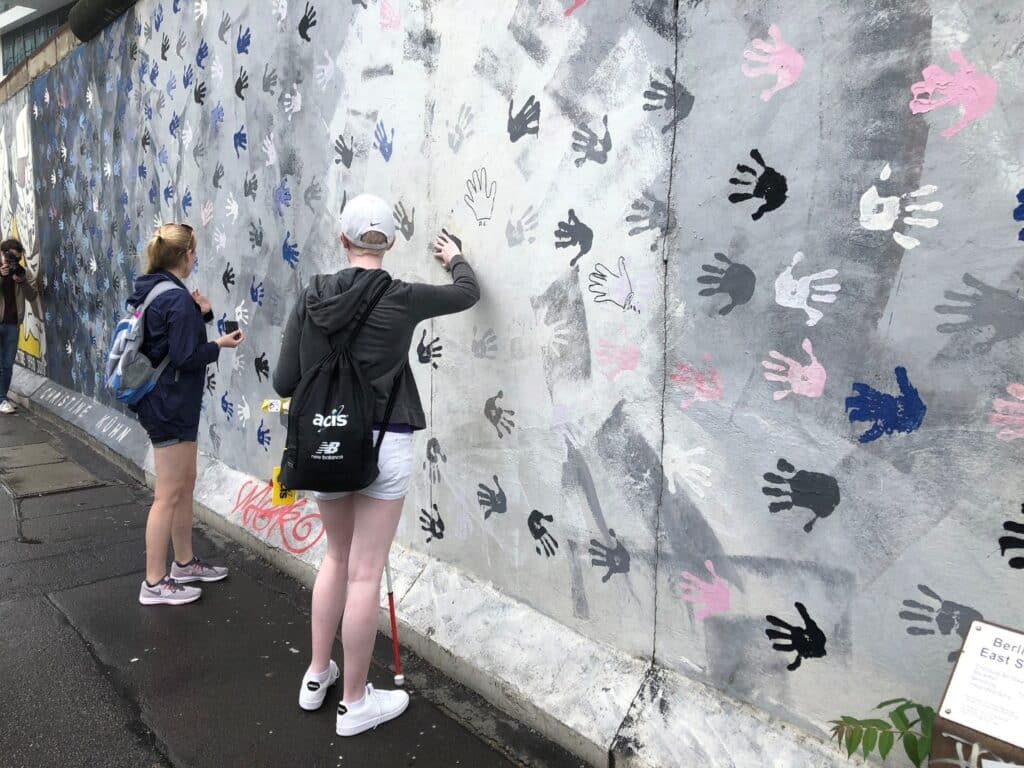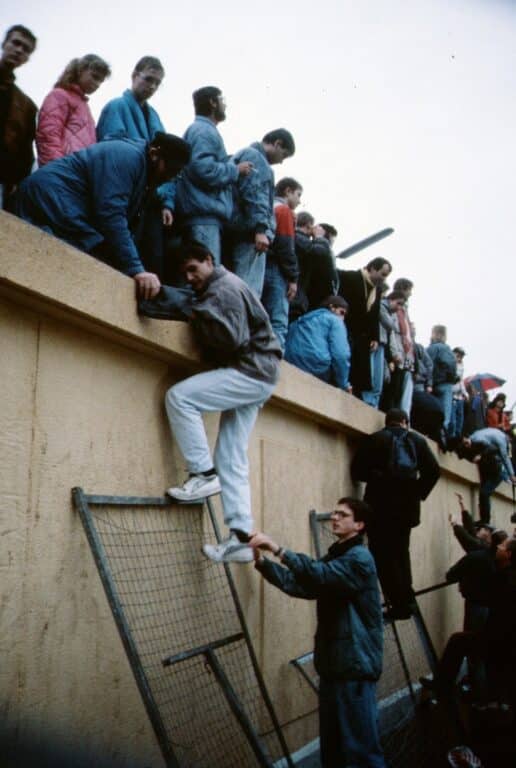The Berlin Wall, 35 Years On

A City Divided
Winston Churchill – perpetually the source of a splendid quote – gave his famous “Iron Curtain Speech” to an audience in London in 1946: WW2 was over, but “From Stettin in the Baltic to Trieste in the Adriatic, an iron curtain has descended across the continent.”
The political division was already there at this point, but it took until 13 August 1961 before the famous Berlin Wall became a physical reality. Just seven weeks prior, Walter Ulbricht, the hated leader of communist East Germany had announced at a West German press conference that “no one has the intention of building a wall”. It was a bare-faced lie. Top-secret plans to do just that were already well underway.
Over the previous fifteen years, a fifth of East Germany’s population had already fled to the West: a brain-drain of millions of teachers, lawyers, doctors, engineers, and young people. The flood was unstainable. And so, around 4 am on that day in 1961, the fences started going up in what became known as “Barbed Wire Sunday”. Berliners who had previously been able to cross between the East and West woke to find the political division of their city becoming a physical reality. In some places the fence – soon to become a wall – cut down the middle of streets.
Some were caught on the wrong side simply by the chance of visiting a friend or relative. During the day, around 800 people made the desperate decision to leave everything behind and managed to get across the division. The following day just twenty succeeded. The East German government told their citizens this was the “anti-fascist protection Wall” built to protect them from the aggressive, corrupt, and decadent West. The truth was, of course, that the guards stationed here had orders to shoot to kill any of their citizens who approached. And shoot they did.
The Impact of the Wall
Over the following decades, the Wall became more and more deadly, and ever more impregnable. There are several excellent places where you can still see the Wall in Berlin today. A firm favorite is the “East Side Gallery”, which runs along the river and has been painted with iconic murals on the eastern side. Another spot is close to the former SS and Gestapo HQ at the outstanding Topography of Terror Museum. Here, where from one location, you can see fascinating physical reminders of 150 years of German history just by turning your head.

In both these places the Wall looks low and almost harmless: a typical reaction from a student is that you could be over that with a decent ladder. But if you also go to what I consider to be the most interesting remaining section of the Wall, you gain a very different perspective. This is at Bernauer Strasse, where you can see what was actually behind the unimpressive grey wall: the foundations of demolished houses, the death strip, the watch towers, and the trip wires.

The Berlin Wall split the city in two, but there was another border: the “Inner German Border”, which was part of Churchill’s Iron Curtain that divided the whole of Europe. Most people refer to the “Wall” and think only of the partition of Berlin. This was also a divide and was just as deadly. It ran almost 860 miles long and split the entire country in two.
As a schoolboy whose dad was stationed with the British army in West Germany, I remember visiting the Harz Mountains in the early 1980s. The border cut its way through the forest and mountains there, splitting neighboring towns into being on one side, or the other. We kids stood and waved at the East German border guards watching us from their fortified towers. There was of course zero reaction. They were only young guys in their early 20s. I wonder what those faces from across the divide are doing today…
There is even a village, called Mödlareuth, which straddles the border between Bavaria and Thuringia. It contains a “Mini Berlin wall” that has been kept as a memorial and open-air museum. Here the Inner German Border split the tiny community of 55 inhabitants into two different states, two political systems, and two worlds. It makes an excellent, fascinating visit on the drive from Berlin to Munich.

A New Chapter
The division of Europe seemed to us like a permanent state. In January 1989, months before the Wall fell, the East German leader proudly declared that the Wall would still be standing in 100 years’ time. I recently reread an excellent book that was published, also in 1989. It is called “The Germans: Rich, Bothered, and Divided”. There is a passing quote from a West German grandmother, Waltraud Martin, who lives in a 600-year-old mill in a sleepy provincial town close to the East German border. Asked when the Wall is likely to come down she says: “We will not experience it, our children also not – and probably the grandchildren won’t either”.
9 November 2024 marks the pivotal night that the impossible became possible. 35 years ago that night, right at the end of a shambolic and confused live TV interview, Günter Schabowski, an East German politburo member who had not read his notes properly, announced that East German citizens would be able to travel freely to the West.. “as far as I know, with immediate effect”. He ended his statement with a shrug.
That announcement caused a surge of people from East Berlin to head to the border crossings to see what was going on. Puzzled guards did not know what to do. A series of panicked calls went up the command chain. No one wanted to take responsibility for what could easily become a bloodbath. It was late in the evening. Finally at 11:30 pm, an East German Stasi major in charge of the Bornholmer Strasse crossing could not reach anyone higher than him and gave the fateful order. “Open the gates”.

Berliners would soon be dancing on top of the hated Wall that had kept them apart for 27 long years. West German grandmother Waltraud Martin’s little town was about to be flooded by a stream of little communist Trabbie cars, backed up for miles at the nearby border crossing. A close friend who grew up in communist Leipzig was nine at the time. He describes his first visit to the West as “like going from a black and white movie to a colour one”.
Of course, nothing is inevitable in history, but those who doubted the pressure to re-unify after the collapse of the physical division missed the fact that East Germany was never actually a “nation”. Poland, Hungary or Romania could and would continue in a different form, even after the domino effect of 9 November on the collapse of communism across central and eastern Europe, but East Germany only existed because of the totalitarian communist system. The division of the nation was in every way an artificial one and its borders broadly matched where the Allied and Soviet troops happened to come to a standstill at the end of WW2. A divided North/South Germany might have resisted the pressure of reunification better because of historical, cultural, and religious differences. But the creation that was the DDR, or East Germany, did not.
Within less than a year, the failed state that had once murdered its own escaping citizens, therefore did in fact cease to exist, and Germany was re-unified as a democratic state. The four victorious nations who had been occupying the country since the end of WW2 would be leaving within a few years.
Present Reflections
Sitting on a high-speed ICE German train as it glides smoothly in the dappled sunlight through the former East German countryside, this all seems so distant and surreal. The Wall has been gone eight years longer than it existed. Today is almost impossible for the casual visitor to know whether they were in the former east or west. Even I have to think carefully, and maybe consult a map to know. Around $2 trillion has been invested since re-unification took place. There are undoubtedly still issues: parts of the former east lag way behind the west in terms of economic development and political extremism is a constant concern. But the Wall, which split communities, separated friends and families, and which affected the life of every German, is gone.
Every time I cross the former “iron curtain” with an ACIS group, I try hard to bring home how momentous a thing it is what we are about to do. I might as well be talking about the American Civil War it is probably so far in the past for them.. and on reflection, that is probably not a bad thing. The Wall is a historical fact, a fascinating thing to visit, and a physical curiosity. That’s just how it should be.
About Tour Manager Peter Ede
Travel, history, architecture, music, languages and more travel are my passions! I’ve been leading ACIS/Encore groups since 1993 all over Europe from Norway right down to Turkey. I’m a corporate lawyer by profession, but a traveller by vocation. I love sharing my appreciation and wonder for the places we go to with my groups, and can’t wait each year to be hitting the road again.











Well written! I was an 11th grade student when the news of the wall coming down was announced. I didn’t understand its history and importance at the time (shame on my history teachers!). One of the great things about ACIS is connecting the history in our travels!
Great article, Peter! I remember being in my apartment in the USA and having my eyes glued to the TV in shock, watching the events of November 9 unfold. What a joyous occasion. I called some German friends that day and they said, “Nobody is at home in Berlin. Everyone is out on the streets!”